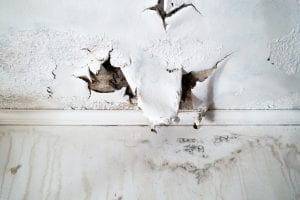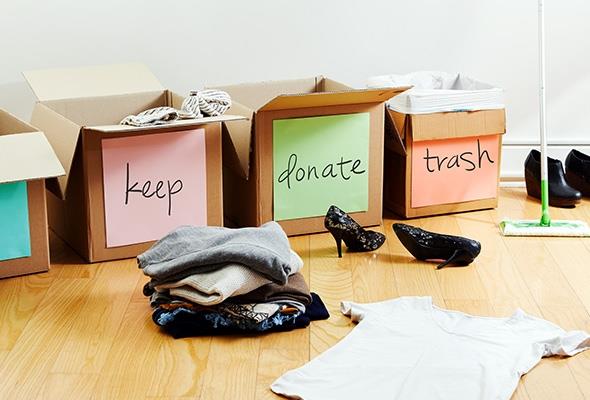When it comes to struggling with cleanliness, there are generally two types of people – people who struggle with clutter, and people who struggle with hoarding.
People with hoarding tendencies compromise their own safety and relationships just to hold on to items that they have become emotionally attached to. They live their daily lives surrounded by things that most others would throw out. But when the health and well being of the home’s occupants are in danger, cleaning up a hoarded home is absolutely necessary. Here are some of the most common dangers of hoarding and the extensive steps involved in the clean-up process.
The Dangers of Hoarding
Fire
 Fire is the main danger in a hoarded home because of the extensive amount of flammable materials among all of the clutter. Fires can easily occur when objects cover a heating vent or damaged wires. Moreover, clutter obstructs pathways and first responders may not be able to navigate a hoarded home to rescue residents.
Fire is the main danger in a hoarded home because of the extensive amount of flammable materials among all of the clutter. Fires can easily occur when objects cover a heating vent or damaged wires. Moreover, clutter obstructs pathways and first responders may not be able to navigate a hoarded home to rescue residents.
Injuries
Injuries can easily occur due to falls or trips on hoarded objects. Piles in a hoarded home can become as high as the ceiling and can collapse and cause injury to anyone in their way. One should never underestimate the danger of getting trapped under debris and contents.
Diseases
Unwanted pests such as rats and cockroaches can infest a hoarded home and go unnoticed for long periods of time, drastically increasing the chance of infecting people with diseases. For residents who live among the clutter on a daily basis, this risk becomes even greater.
Learn More: The Impact of Property Damage on Your Health
Air Quality
With clutter comes dust, odors and even ammonia from decaying waste products. These can cause serious air quality issues in the hoarder’s home. It may become difficult to breathe and respiratory problems may develop for people and pets.
Health Hazards
 The combination of water damage and organic material is the perfect recipe for unwanted growth, especially in an already humid environment like The Woodlands, Texas. Many hoarders also have difficulty throwing away food or waste from food. In a hoarded home, mold can quickly grow in, on, and around your walls, floors, and ceilings. Over time, this can cause respiratory and other health problems, especially for those with already-existing allergies.
The combination of water damage and organic material is the perfect recipe for unwanted growth, especially in an already humid environment like The Woodlands, Texas. Many hoarders also have difficulty throwing away food or waste from food. In a hoarded home, mold can quickly grow in, on, and around your walls, floors, and ceilings. Over time, this can cause respiratory and other health problems, especially for those with already-existing allergies.
Learn More: The Dangers of Mold Exposure
Structural Integrity
Over time, hoarding can cause damage to the building itself due to the overwhelming weight of the excessive contents hoarders put in them. This could cause the floors or walls to collapse, creating a much bigger problem.
Building Maintenance
Excessive clutter can prevent technicians from performing necessary maintenance on HVAC equipment and sprinkler systems, creating a safety hazard.
Hoarding Clean-Up Procedures
Hoarding clean up is no easy task and is best left to the restoration professionals who have the expertise and equipment to perform the job efficiently and safely.
Ensuring Safety
When cleaning out a hoarded home, it’s extremely important that workers wear protective gear such as disposable gloves, protective shoes, and dust masks, to help guard themselves against bacteria and diseases. They should also have a fire extinguisher, repellent spray, a flashlight, and a first-aid kit on hand and easily accessible.
 Cleaning Supplies
Cleaning Supplies
Technicians and those helping with the clean-up process need to come prepared with tools and cleaning equipment to remove the trash and clean the home. This includes things like heavy-duty trash bags, empty boxes, buckets, gloves, cleaning agents and disinfectants, mops and brooms.
Preparing a Staging Area
A free, open space outside of the home is required to temporarily place the contents as they are removed. A large dumpster is a helpful way to safely dispose of unwanted items.
Decluttering the Home
Once the staging area is ready, workers can tackle the home starting in the room with the closest exit to ensure a quick escape in case of an emergency. Trash and clutter should be removed from the room starting from the top and working down to the bottom. This helps prevent piles and stacks from falling over and causing injuries.
Sorting Out the Contents
 Those cleaning out a hoarded home should check the local regulations for how to handle items that can’t go directly into the trash (such as paints or explosives). Trash and debris that is safe to throw away should be bagged and thrown into the dumpster. Salvageable items should be sorted into items to keep and items to donate.
Those cleaning out a hoarded home should check the local regulations for how to handle items that can’t go directly into the trash (such as paints or explosives). Trash and debris that is safe to throw away should be bagged and thrown into the dumpster. Salvageable items should be sorted into items to keep and items to donate.
Repairing and Cleaning the Home
Once the entire home is clutter-free, it’s essential to address any repairs that need to be done. These can include things like repainting, re-carpeting, or even damage restoration (after a fire, water, mold, or biohazard damage). Be sure to disinfect any salvageable items.
Hoarding is not something that has to consume your life. With a little help and guidance, you, too, can live clutter-free.





 PuroClean of The Woodlands
PuroClean of The Woodlands